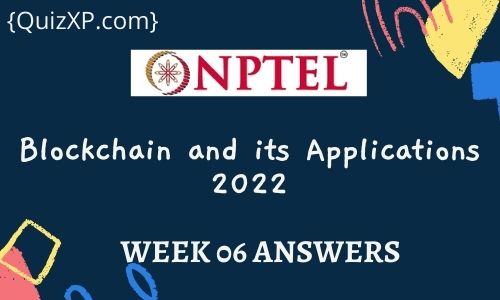Are you looking for the Answers to NPTEL Blockchain and its Applications Assignment 6? This article will help you with the answer to the National Programme on Technology Enhanced Learning (NPTEL) Course “ NPTEL Blockchain and its Applications Assignment 6 “
What is Blockchain and its Applications?
In the last few years, Blockchain technology has generated massive interest among governments, enterprises, and academics, because of its capability of providing a transparent, secured, tamper-proof solution for interconnecting different stakeholders in a trustless setup. In January 2021, the Ministry of Electronics and Information Technology (MeiTY), Government of India, published the first draft of the “National Strategy on Blockchain” that highlights 17 potential applications that are of national interest.
Against this backdrop, this subject will cover the basic design principles of Blockchain technology and its applications over different sectors. Additionally, the course also provides tutorials on setting up blockchain applications using one of the well-adopted permissionless blockchain platforms – Ethereum, and one permission blockchain platform – Hyperledger.
CRITERIA TO GET A CERTIFICATE
Average assignment score = 25% of the average of best 8 assignments out of the total 12 assignments given in the course.
Exam score = 75% of the proctored certification exam score out of 100
Final score = Average assignment score + Exam score
YOU WILL BE ELIGIBLE FOR A CERTIFICATE ONLY IF THE AVERAGE ASSIGNMENT SCORE >=10/25 AND EXAM SCORE >= 30/75. If one of the 2 criteria is not met, you will not get the certificate even if the Final score >= 40/100.
Below you can find the answers for NPTEL Blockchain and its Applications Assignment 6
| Assignment No. | Answers |
|---|---|
| Blockchain and its Applications Assignment 1 | Click Here |
| Blockchain and its Applications Assignment 2 | Click Here |
| Blockchain and its Applications Assignment 3 | Click Here |
| Blockchain and its Applications Assignment 4 | Click Here |
| Blockchain and its Applications Assignment 5 | Click Here |
| Blockchain and its Applications Assignment 6 | Click Here |
| Blockchain and its Applications Assignment 7 | Click Here |
| Blockchain and its Applications Assignment 8 | Click Here |
NPTEL Blockchain and its Applications Assignment 6 Answers:-
Q1. If there are 24 faulty nodes (crash fault) in asynchronous CFT, at least how many nodes needed to reach consensus.
a) 48
b) 49
c) 50
d) 51
Answer: b) 49
Q2. In Paxos, a node can have only one role among the three roles at a time. True or False
a) False
b) True
Answer: a) False
Q3. Can we reach a consensus when there is one commander, one good lieutenant, and one faulty lieutenant in a Byzantine Generals Problem. Yes or No?
a) Yes
b) No
Answer: b) No
Q4. If there are 24 faulty nodes in, at least how many needed to reach consensus in the Byzantine Fault Tolerance (BFT) system.
a) 72
b) 73
c) 48
d) 49
Answer: b) 73
Next Week Assignment Answers
Q5. Which are the examples of the synchronous consensus techniques?
a) RAFT
b) PAXOS
c) Byzantine General Model
d) Practical Byzantine General Model
Answer: c) Byzantine General Model
Q6. Suppose you execute your tasks distributedly from six different locations. For maintaining the consensus among the systems, you are using the BFT model. You found that one system is permanently failed due to a hardware fault and another system is compromised by an attacker. Does your system correctly work at all?
a) No
b) Yes with the remaining nodes
c) Yes will all the nodes
Answer: b) Yes with the remaining nodes
If there are any changes in answers will notify you on telegram so you can get a 100% score, So Join
Q7. Which of the statements are true?
a) Paxos is based on state-machine replication
b) In Paxos, Proposers and Learners maintain a state of the running epochs
c) In a Paxos, once a consensus is reached, Paxos cannot progress to another consensus
d) Paxos works in two rounds
Answer: a), b), c), d)
Q8. State machine replication-based consensus is used over permissioned blockchains.
Select the suitable reason(s)?
a) The network is closed, and the nodes know each other, hence state replication is possible among the known nodes
b) Not need to spend power, time, or bitcoin
c) Machines can behave maliciously, hence consensus in required
d) State machine replication-based consensus is not recommended to use over permissioned bloackchains
Answer: a), b), c)
Q9. Which are the properties of an asynchronous consensus:
a) Validity
b) Agreement
c) Termination
d) Integrity
Answer: a), b), c)
Q10. The following code snipper from paxos algorithm belongs to which phase?
is the ID the largest I have seen so far, max_id == N?
if yes
reply with an ACCEPTED message & send ACCEPTED(ID, VALUE) to all learners
if no
do not respond (or respond with a “fail” message)
a) PREPARE-PROMISE
b) PROPOSE-ACCEPT
Answer: b) PROPOSE-ACCEPT
For other courses answers:- Visit
For Internship and job updates:- Visit
Disclaimer: We do not claim 100% surety of answers, these answers are based on our sole knowledge, and by posting these answers we are just trying to help students, so we urge do your assignment on your own.
if you have any suggestions then comment below or contact us at [email protected]
If you found this article Interesting and helpful, don’t forget to share it with your friends to get this information.



